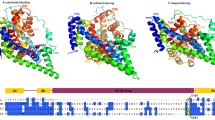Abstract
We have generated a fully functional dopamine transporter (DAT) mutant (dmDATx7) with all cysteines removed except the two cysteines in extracellular loop 2 (EL2). Random mutagenesis at either or both EL2 cysteines did not produce any functional transporter mutants, suggesting that the two cysteines cannot be replaced by any other amino acids. The cysteine-specific reagent MTSEA-biotin labeled dmDATx7 only after a DTT treatment which reduces disulfide bond. Since there are no other cysteines in dmDATx7, the MTSEA-biotin labeling must be on the EL2 cysteines made available by the DTT treatment. This result provides the first direct evidence that the EL2 cysteines form a disulfide bond. Interestingly, the DTT treatment had little effect on transport activity suggesting that the disulfide bond is not necessary for the uptake function of DAT. Our results and previous results are consistent with the notion that the disulfide bond between EL2 cysteines is required for DAT biosynthesis and/or its delivery to the cell surface.
Similar content being viewed by others
Abbreviations
- DA:
-
Dopamine
- NE:
-
Norepinephrine
- 5-HT:
-
5-Hydroxytryptamine
- DAT:
-
Dopamine transporter
- NET:
-
NE transporter
- SERT:
-
5-HT transporter
- mDAT:
-
Mouse DAT
- dmDAT:
-
Drosophila melanogaster DAT
- TM:
-
Transmembrane domain
- EL:
-
Extracellular loop
Reference
Amara SG, Arriza JL (1993) Neurotransmitter transporters: three distinct gene families. Curr Opin Neurobiol 3:337–344
Rudnick G, Clark J (1993) From synapse to vesicle: the reuptake and storage of biogenic amine neurotransmitters. Biochim et Biophys Acta 1144:249–263
Goodnick PJ (1991) Pharmacokinetics of second generation antidepressants: bupropion. Psychopharmacol Bull 27:513–519
Ritz MC, Lamb RJ, Goldberg SR, Kuhar MJ (1987) Cocaine receptors on dopamine transporters are related to self-administration of cocaine. Science 237:1219–1223
Giros B, Caron MG (1993) Molecular characterization of the dopamine transporter. Trends Pharmacol Sci 14:43–49
Gu H, Wall SC, Rudnick G (1994) Stable expression of biogenic amine transporters reveals differences in inhibitor sensitivity, kinetics, and ion dependence. J Biol Chem 269:7124–7130
Ascher JA, Cole JO, Colin JN, Feighner JP, Ferris RM, Fibiger HC, Golden RN, Martin P, Potter WZ, Richelson E, et al. (1995) Bupropion: a review of its mechanism of antidepressant activity. J Clin Psychiatry 56:395–401
Seeman P, Madras BK (1998) Anti-hyperactivity medication: methylphenidate and amphetamine [In Process Citation]. Mol Psychiatry 3:386–396
Han DD, Gu HH (2006) Comparison of the monoamine transporters from human and mouse in their sensitivities to psychostimulant drugs. BMC Pharmacol 6:6
Yamashita A, Singh SK, Kawate T, Jin Y, Gouaux E (2005) Crystal structure of a bacterial homologue of Na+/Cl− dependent neurotransmitter transporters. Nature 437:215–223
Wang JB, Moriwaki A, Uhl GR (1995) Dopamine transporter cysteine mutants: second extracellular loop cysteines are required for transporter expression. J Neurochem 64:1416–1419
Chen JG, Liu-Chen S, Rudnick G (1997) External cysteine residues in the serotonin transporter. Biochemistry 36:1479–1486
Wu X, Gu HH (2003) Cocaine affinity decreased by mutations of aromatic residue phenylalanine 105 in the transmembrane domain 2 of dopamine transporter. Mol Pharmacol 63:653–658
Nelson RM, Long GL (1989) A general method of site-specific mutagenesis using a modification of the Thermus aquaticus polymerase chain reaction. Anal Biochem 180:147–151
Chen R, Han DD, Gu HH (2005) A triple mutation in the second transmembrane domain of mouse dopamine transporter markedly decreases sensitivity to cocaine and methylphenidate. J Neurochem 94:352–359
Seal RP, Leighton BH, Amara SG (1998) Transmembrane topology mapping using biotin-containing sulfhydryl reagents. Methods Enzymol 296:318–331
Chen R, Wu X, Wei H, Han DD, Gu HH (2006) Molecular cloning and functional characterization of the dopamine transporter from Eloria noyesi, a caterpillar pest of cocaine-rich coca plants. Gene 366:152–160
Hastrup H, Karlin A, Javitch JA (2001) Symmetrical dimer of the human dopamine transporter revealed by cross-linking Cys-306 at the extracellular end of the sixth transmembrane segment. Proc Natl Acad Sci USA 98:10055–10060
Acknowledgement
This work was supported by a grant from National Institute on Drug Abuse (DA014610).
Author information
Authors and Affiliations
Corresponding author
Additional information
Rong Chen and Hua Wei contributed equally to this manuscript.
Rights and permissions
About this article
Cite this article
Chen, R., Wei, H., Hill, E.R. et al. Direct evidence that two cysteines in the dopamine transporter form a disulfide bond. Mol Cell Biochem 298, 41–48 (2007). https://doi.org/10.1007/s11010-006-9348-7
Received:
Accepted:
Published:
Issue Date:
DOI: https://doi.org/10.1007/s11010-006-9348-7




